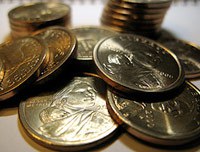Dollar Coins Save The Government Money Because You'll Just Throw Them In A Jar
Here at The Consumerist, we have a long-standing anti-penny stance, but we’re somewhat in favor of the gold-colored dollar coins. They’re shiny! The Sacagawea ones have a woman on them! They save the government money! Except a new Government Accountability Office report mentions something interesting that we haven’t discussed here before. Just replacing more fragile dollar bills with durable coins doesn’t save any money at all. Minting and distributing all of those coins costs a lot. Instead, all of the cost savings would come from Americans throwing dollar coins in jars instead of circulating them.
The key word here is “seigniorage.” That’s the difference between what it costs to manufacture and distribute physical currency, and the face value of that currency.
Seigniorage was the reason why the state quarter program was so successful from the government’s point of view. Think of all of those coins sitting in folders, never to be circulated again. Unless you’re really, really broke and need to do laundry. Not that I would know anything about that.
As the report explains in its executive summary:
If the interest savings due to increased seigniorage are excluded from the analysis, the government would incur a total net loss of about $1.8 billion over 10 years, or an average of $179 million per year. With no interest savings to offset the costs of coin production, net losses would be incurred in 9 of the 10 years.
To translate that from bureaucrat to English: without seignorage, if there were no change to Americans’ spending behavior at all, switching to dollar coins would be a stupid and expensive move. Coins cost more to make than bills, but stay in circulation longer. It’s a common misconception that the longer lifespan of coins is the reason why switching to them saves the government money. That’s not so: without seigniorage, the switch would cost the government, on average, an extra $180 million per year.
The analysis shows that every two dollar bills yanked from circulation would have to be replaced with three coins, because coins tend to accumulate. Bills don’t. In theory, we would need more dollar coins to replace the current supply of dollar bills, but that’s just a theory. Maybe the threat of walking around with pockets full of coins would make everyone use credit or debit cards more, and those coins will all just stay snug in their vaults.
Alternative Scenarios Suggest Different Benefits and Losses from Replacing the $1 Note with a $1 Coin [Government Accountability Office]
Should We Kill The Dollar Bill? [NPR]
PREVIOUSLY:
Senators Push Legislation To Make Dollar Coin More Than A Novelty Item
$1 Billion In Unwanted Dollar Coins Lurk In Government Bunkers
Want more consumer news? Visit our parent organization, Consumer Reports, for the latest on scams, recalls, and other consumer issues.


